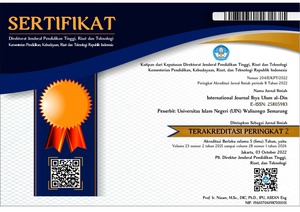KARAKTER HUBUNGAN DAN HARMONISASI KEHIDUPAN ANTARA KELOMPOK KEAGAMAAN RIFA’IYAH DAN NU
DOI:
https://doi.org/10.21580/ihya.17.1.1733Keywords:
Harmonization, Relationship characters, Religious GroupsAbstract
This research is to reveal the socio-religious conflicts that have been occurred between the religious group of Rifa’iyah and NU (Nahdlatul Ulama). The result of this research showed that economic competition has resulted in social conflicts and tensions. There has been a sensitive relation between religious groups of Rifa’iyah and NU. In ordert to create and keep a harmony, both need various activities that include togetherness between Rifa’iyah and NU as a social cohesion. In the future, religious spirit and ‘corporate culture’ is a model how to develop a harmony, which can provides support for preventing conflict. This research is classified as qualitative research. The data in this research is collected using three of data collection techniques, namely observation, participative observation, and indepth-interview. The analysis data used in this research is triangulation analysis techniques with attention to emic and ethic perspective.---
Penelitian ini bertujuan untuk mengungkap konflik sosio-religius yang terjadi antara kelompok keagamaan Rifa'iyah dan NU (Nahdlatul Ulama). Hasil penelitian ini menunjukkan bahwa persaingan ekonomi telah mengakibatkan konflik sosial dan ketegangan di antara dua kelompok tersebut. Terdapat hubungan sensitif antara kelompok agama Rifa'iyah dan NU. Dalam rangka menciptakan dan menjaga harmoni, keduanya membutuhkan berbagai kegiatan yang mencakup kebersamaan antara Rifa'iyah dan NU sebagai sebuah kohesi sosial. Ke depan, semangat religius dan 'budaya perusahaan' adalah model bagaimana mengembangkan harmoni, yang bisa memberi dukungan untuk mencegah konflik. Penelitian ini diklasifikasikan sebagai penelitian kualitatif. Data dalam penelitian ini dikumpulkan dengan menggunakan tiga teknik pengumpulan data, yaitu observasi, observasi partisipatif, dan indepth-interview. Data analisis yang digunakan dalam penelitian ini adalah teknik analisis triangulasi dengan memperhatikan aspek emik dan etik.
Downloads
References
Appadurai, Arjun, “Global Ethnoscape: Notes and Queries for Transnational Anthropology”, dalam R.G. Fox (ed.), Recapturing Anthropology, Santa Fee, NM: School of America Research Press, 1991.
Berger, Peter dan Thomas Luckmann, The Social Construction of Reality. New York: Penguin Books, 1979.
______, Tafsir Sosial atas Kenyataan, Jakarta: LP3ES, 1990.
Bourdieu, Pierre, An Introduction to the Work of Pierre Bourdieu: The Practice Theory, London: The Macmilland Press Ltd., 1990.
Bungin, Burhan (ed), Analisis Data Penelitian Kualitatif: Pemahaman Filosofis dan Metodologis Ke Arah Penguasaan Model Aplikasi, Jakarta: Raja Grasindo Persada, 2003.
Darban, Adabi, Rifaiyah Gerakan Sosial Keagamaan di Pedesaan Jawa Tengah Tahun 1850-1982, Tesis, Yogyakarta: UGM, 1987.
Djamil, Abdul, Perlawanan Kiai Desa, Yogyakarta: LKiS, 2001.
Geertz, Clifford, Tafsir Kebudayaan, Yogyakarta: Kanisius, 1992.
Green, J. W, 1995. Cultural Awarness in the Human Service, Boston: Allyn and Bacon.
Hasbullah, Dasar-Dasar Ilmu Pendidikan, Jakarta: Rajawali Press, 2008.
Kettani, M. Ali, Minoritas Muslim di Dunia Dewasa ini, Jakarta: PT. Raja Grafindo Persada, 2005.
Sanjek, R. (ed.). Fieldnotes: The Makings of Anthropology, Ithaca and London: Cornell University Press, 1990.
Downloads
Published
How to Cite
Issue
Section
License
By submitting an article to the journal, the author(s) agree to transfer the published article's copyright to the journal, which will act as the publisher. This means the journal will have the right to publish the article in various forms, including reprints. The journal will maintain the publishing rights to the published articles.
This work is licensed under Creative Commons Attribution-ShareAlike 4.0 International License.
In line with the license, authors and third parties (readers, researchers, and others) are allowed to share and adapt the material. In addition, the material must be given appropriate credit, provided with a link to the license, and indicated if changes were made. If authors remix, transform or build upon the material, authors must distribute their contributions under the same license as the original.



